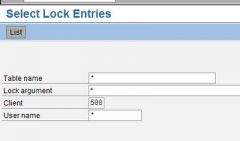![]()
![]()
![]()
Use LEFT and RIGHT arrow keys to navigate between flashcards;
Use UP and DOWN arrow keys to flip the card;
H to show hint;
A reads text to speech;
22 Cards in this Set
- Front
- Back
|
When are SAP locks set?
|
SAP lock are set by the executing work process when a user / job wants a change access to data.
|
|
|
When does a SAP lock fail?
|
A lock is refused when the respective work process checks in the locktable s to whether a respective lock conflicts with an existing entries in the locktable.
|
|
|
Where are SAP lock entries stored?
|
In the lock table.
|
|
|
How many types of locks are there in a SAP system?
|
There are 4 types of locks:
1. Write locks (E) aka EXCLUSIVE 2. Read locks (S) aka SHARED 3. Enhanced write locks (X) aka EXCLUSIVE NON-CUMULATIVE 4. Optimistic locks (O) |
|
|
What other name is a write lock (E) commonly known as?
|
Exclusive lock
|
|
|
What is a write lock / exclusive (E) lock?
|
Lock data can be edited by only one user.
Any other requests from work processes to set another write lock or read lock are rejected. |
|
|
What is a cumulate lock?
|
In an exclusive (write) lock. A cumulate lock can be applied on the lock data by the same lock owner again
|
|
|
What other name is a read lock (S) commonly known as?
|
Shared lock.
|
|
|
What is a read lock / shared (S) lock?
|
In an read (shared) lock several users can have read access to the locked data at the same time.
Additional read lock requests are entertained even if they are from different users. However a write lock is rejected |
|
|
What other name is a enhanced write locks (X) commonly known as?
|
Exclusive non-cumulative lock mode.
|
|
|
What is an enhanced write locks / exclusive non-cumulative lock (X) ?
|
An enhanced write lock can be requested only once even if it is by the same transaction.
|
|
|
What is the difference between write locks(E) and Enhanced write lock(X)
|
Difference between write locks(E) and Enhanced write lock(X) is write locks can be set and released by the same transaction several times but X type locks can also be set once even by the same transaction.
|
|
|
What is an optimistic lock?
|
These locks are set up when the users displays the data in change mode.
|
|
|
How many optimistic locks can be setup on the same data?
|
Several optimistic locks can be setup on the same data.
|
|
|
What type of lock does an optimistic lock start out as?
|
Optimistic locks are read locks(S) at first
|
|
|
When are optimistic locks converted to write / exclusive locks?
|
Optimistic locks are read locks(S) at first and converted to write lock (E) when the users wants to save the data.
|
|
|
What happens to all other optimistic locks when one optimistic lock on data is changed to write / exclusive lock?
|
If an optimistic locks on a data is changed to write lock(E), all other optimistic locks on that data will be deleted.
|
|
|
When are all other optimistic locks on that data deleted?
|
When one optimistic lock on data is changed to write / exclusive lock
|
|
|
When a program is responsible for setting locks, how can the lock be released?
|
Locks that are set by an application program are released by the program itself or they are released by the update program once the database has been changed
|
|
|
What TCODE is used to monitor SAP locks?
|
SM12
|
|

What does the above screen represent and what actions can be performed from here?
|
Here you have option of selecting locks based on following parameters:
1. tablename 2. lock argument 3. client 4. username |
|

What does the above screen represent and what action can b performed from here?
|
From here if you encounter some old SAP locks and after thorough analysis, you would like to delete these, it can be done in the following ways :
Select the locks and delete the lock from SM12 Identify the user who has set the respective lock and end the user session using SM04 transaction code. |

